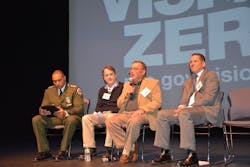What New York City and its fleets are doing to reduce crashes
Nov. 6, 2015
5 min read
QUEENS, NY. Zero fatalities and zero major injuries on its streets is New York City’s motto behind Mayor Bill de Blasio’s movement to improve traffic safety. The movement is called Vision Zero and it involves a task force from various city departments to reduce traffic-related deaths in the city that never sleeps.During Vision Zero’s second forum, held Nov. 5 at the Queens Theatre, New York City fleets, the police department, and other city officials gathered to discuss fleet best practices in safety, particularly concerning what both public and private fleet operators are doing to reduce collisions and costs.According to Vision Zero statistics, approximately 4,000 New Yorkers are seriously injured and more than 250 are killed each year in traffic crashes. Being struck by a vehicle is the leading cause of injury-related death for children under 14, and the second leading cause for seniors. On average, vehicles seriously injure or kill a New Yorker every two hours.Thomas M. Chan is New York City Police Department’s chief of transportation. He told attendees that since Vision Zero’s implementation, the city has seen a 15% decrease in crash-related fatalities in the last year. He also noted that overall fatalities are down 14% this year compared to last.One fleet that has adopted the city’s vision and implemented various safety initiatives and technologies is AmbuTrans, a company that transports mobility challenged, elderly and disabled patients to their medical appointments. President Neal Kalish explained that since the company has installed Lytx DriveCams in its vehicles and the Mobileye collision avoidance/early warning system throughout its fleet, the company went from having one or two collisions or traffic-related events per month down to approximately two events over the past 15 months. The company has also implemented GPS monitoring, more in-depth driver training and “rigorous” fleet maintenance, Kalish said.“As a fleet operator our decisions matter even more because we are held accountable for every decision the driver makes behind the wheel,” he explained. He also added that the company will not hire drivers who have more than two points against them on their MVR [motor vehicle report], and that all employees must pass a pre-employment physical and wheelchair training before they’re hired.Like Kalish, Ken Levine, the corporate safety director of waste collector Action Carting, also has installed various safety technologies within his fleet. Action Carting operates 100 trucks in New York City, and Levin said the trucks mostly work through the night and pick up around 37 tons of trash per night. To enhance fleet safety, Levine noted the company uses cameras and collects analytics data. But the cameras are used mainly as a training tool, rather than a disciplinary tool, he said. Levine said the company has installed AWT’s 3rd Eye cameras to help prevent crashes and reduce risks. When the device is triggered, Levine explained, whether from abrupt G-force, hard brake, or lane deviation, the company sends Action Carting the data and a video of the driver. “We take it to monthly meetings and use it as a training tool,” Levine explained. “We look at what did the person do right, what did they do wrong, what could they have done better.”
About the Author

Cristina Commendatore
Cristina Commendatore is a past FleetOwner editor-in-chief. She wrote for the publication from 2015 to 2023.
Sign up for our eNewsletters
Get the latest news and updates

